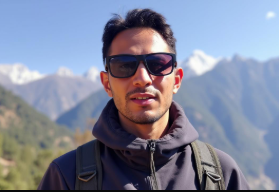Peaky Peak Trek
Trip Type
Trekking In Nepal
Accomodation
Tea House
Destination
Nepal
Start Point
Kathmandu
Region
Everest Region
Duration
7 Days
Pikey Peak Trek is based in the lower Everest Region of Nepal. This trek is well known for its amazing sunrise view of Mount Everest along with other mountain vistas. It is one of the most relaxing treks standing at an altitude of 4,065 m. This trek is for those who are looking for an authentic experience of nature within a small span of time. The route passes through Sherpa villages, Buddhist Monasteries, rhododendron, and open ridge providing cultural and natural beauty.
Seasonal Information
Weather influences the experience of trekkers during the trek. Choosing the best season to trek with clear skies and temperature is crucial so here is the seasonal information for your trek.
-
Spring(March-May) is the best season for your trek.You can experience the mild temperature. Clear skies with the panoramic view of Mount Everest, Kanchenjunga and Annapurna. It is also the best for photography.
-
Autumn(September-November) is also the best season where the temperature is moderate and the visibility is excellent. It is also the festive season and comfortable for trekking.
-
The other two seasons are winter(december-february), in this season the temperature is cold and you can see few trekkers. Likewise in monsoon(June-August), there is heavy rainfall and because of that the trails are slippery, also you get to see fewer mountains because of the fogg. So this season is highly not recommended.
Cultural and Natural Insights
You can explore the Sherpa, Tamang and Rai communities and experience their unique culture and tradition.You get to visit ancient Buddhist monasteries that include Thupten Choling Monastery. You can witness traditional yak herding and farming styles in remote villages. Also you can engage in local festivals and rituals especially in Autumn. Similarly, for natural insights, you can witness the mesmerising sunrise view of Mount Everest, Lhotse, Makalu. You can walk through the forest of rhododendrons, pine woodlands and open ridges. You can spot wildlife like Himalayan musk deer, Himalayan Monals and langurs.You can experience over the top landscapes including high ridges, terraced fields and deep valleys.
Preparation Guide
For Physical fitness :
-
Do cardio exercise, train to increase your strength for long walking
-
You can practice walking with a backpack, you can go for short hikes with friends and family.
For Packing Essentials:
-
For clothing, you need layered clothes, jackets, gloves, and trekking boots.
-
For gear you need trekking poles, sunglasses, sunscreen, sleeping bag
-
You need permits of Sagarmatha National Park Permit and TIMS permit
-
You need to carry first-aid, water purification tablets.
Sustainability and Responsibility
-
Use reusable water bottles, you should avoid plastic waste.
-
Stay in local tea houses and you can buy products from local people and contribute in local economy of region
-
You should carry your own garbage to prevent from pollution in remote areas
-
Respect the locality of people like ask permission before taking photos, you should respect the value of monasteries.
It is our responsibility to preserve the beauty of the region for the future generation. It is very important to balance nature.
Why Choose Nepal Outdoor Expeditions for Your First Trek in Nepal?
At Nepal Outdoor Expeditions, we’re dedicated to making your first trekking experience in Nepal smooth, safe, and truly enjoyable. Our friendly, knowledgeable guides ensure a relaxed pace, beginner-friendly trails, and constant support along the way. Whether you're new to trekking or simply looking for a comfortable adventure, we take care of the details, so you can focus on enjoying the journey, the culture, and the breathtaking scenery with total peace of mind.
Modern Trekkers Expectation
-
You get cosy tea houses, they are basic but very comfortable lodges,
-
You get standard meal for breakfast, lunch and dinner
-
You should carry cash as there is no service of ATM
-
Hiring the local porter/guide will give you ethical trekking experience.
-
Due to high risk of altitude sickness acclimatisation for the day is needed.
As trekkers seek balance between adventure and the outside world. Pikey Peak trek tries to meet the expectations of modern trekkers.
Treks You Might Like
If you're looking for more inspiring journeys through Nepal's beautiful landscapes, here are a few treks you might enjoy:
Highlights of the Peaky Peak Trek
Highlights:
-
Stunning sunrise view of Mount Everest along with other mountain vistas
-
Visit of Monasteries, mani walls and spiritual atmosphere
-
You get see diverse landscape like rhododendron forest, alpine forest and terraced farms
-
It is less crowded and peaceful trek
-
Explore the culture of Sherpa, Tamang, and Rai
Short Itinerary ( 7 days )
Arrival in Kathmandu and start the scenic journey from Kathmandu to Dhap by road, passing through greenery hills. Therefore Dhap is the small settlement where you’ll stay overnight. Distance:250 km, altitude gain 1450 m.
The first day of trekking to Jhapre passing through beautiful rhododendron forest and terraced field, You’ll pass through remote sherpa village. Therefore Jhapre is a beautiful village with the stunning sunset of Everest and Numbur Himal. Distance: 13 km, walking hours: 4-5 hrs, altitude loss : 30m
It becomes more challenging as you gain altitude. The route passes through dense forest, yak pastures, and traditional mani walls. Reaching Peaky Peak Base Camp, you’ll rest for the remaining day and prepare yourself for an early morning stunning sunrise view. Distance: 12 km, walking hours: 5-6 hrs. Altitude gain: 820m
This is the most challenging day of the trek. You’ll wake early to climb Peaky Peak Summit(4,065 m) and witness the stunning sunrise. At the top you can see the stunning view of mountain vistas. After that we’ll descend towards Junbesi. It is a charming Sherpa village with a rich Buddisht culture. Distance:16 km, walking hours: 6-7 hrs, altitude gain: 425 m and altitude loss: 1,365 m
It is a short trek to Thupten Choling Monastery. It is one of the largest Buddhist Monasteries in the region. It is the home for manu monks and nuns who believe in Buddhism practice. After reaching there you’ll get time to explore the monastery, meditate and interact with monks. This is an easy trail with some uphill and downhill sections. Distance: 8 km, walking hours: 3-4 hrs, altitude gain/loss:220 m
it is the final trekking day that takes you to trek from Junbesi to Phaplu. You get to pass through small villages, scenic rivers. It is mostly downhill. Phaplu is a small village with local markets, restaurants, bakeries. You stay overnight in Phaplu. Distance: 11 km, walking hours: 5-6 hrs, altitude loss: 450m
It is a long distance scenic route to Kathmandu. After reaching Kathmandu you’ll rest for a while and transfer to the International airport for your departure. Distance: 250 km, altitude loss 1070 m.
Cost Includes
-
Cost for Kathmandu-Dhap and Phapu-Kathmandu transportation
-
Cost of Accommodation in tea houses during trek
-
Standard meals for breakfast, lunch and dinner
-
Emergency medical services cost
-
Trekking permits cost
-
Porter/guide cost
Cost Excludes
-
International flights and Nepal Visa cost
-
Travel insurance
-
Tips for a guide/ Porters
-
You personal experience




